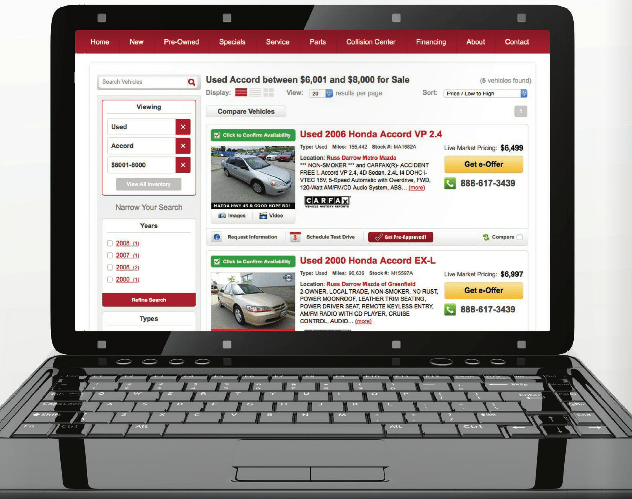If searches don’t take them directly to the relevant message for that make and model, they will keep looking elsewhere. BY FRANK J. LOPES
How does your dealership measure user satisfaction when it comes to your website? Is it based on the number of inventory searches, or the number of vehicle views? Do you regard the length of time a visitor spends on your site as the most important metric, or do you cover lead submissions more?
Ask 10 different dealers how they evaluate website experience and you’ll probably get five different answers (the other five will more than likely answer honestly, “I don’t know” – such a shame!). I can tell you with 100 percent certainty that by properly but aggressively using custom landing pages (those designed with the main purpose of providing relevant and targeted information, in response to a search or other click prompt), the levels of interaction, engagement and leads all will increase. Positive results in these three areas are sure indicators of heightened customer satisfaction with your website offerings.
Logically, a dealer thinks the website homepage is where potential customers begin an online experience with their dealership. However, shoppers who already have zeroed in on a make and model only want to decide where to buy, so they may welcome your home page with the same feeling as when you realize the store you want is on the opposite side of a long mall. The last thing you want is for your website’s navigation bar to be read with the same impatience and frustration that those color-coded mall kiosk maps get (“So we are in Zone A, and Macy’s is in Zone F?”).
Paid-Ad Clicks Should Be Direct
Yet, we set up a similar scenario every time a customer searches for a specific make or model and click on a dealer’s paid ad, only to be brought to an inventory search results page (SRP). It’s the equivalent of a customer walking into a Toyota dealership asking to see a salesperson who can discuss a new Camry, and being told to drive over to the storage lot and pick out a Camry in the back corner and wait for someone to come help. The frustrated customer would simply leave and find another dealership.
And, the same negative outcome arises when a potential customer clicks on an SEM (search engine marketing) ad that shows his or her desired make and model at an advertised price, and the click goes to an SRP page with the aforementioned price nowhere in sight. That shopper probably immediately thinks, “Eh, typical car dealer shenanigans” and moves on to the next ad. It’s even worse if the price that came up on the search page doesn’t match the one on your website; now that customer thinks your dealership doesn’t pay attention to details.
Dealers Need To Manage Marketing
Misdirected and misguided clicks have been a problem ever since search marketing first appeared in dealer’s advertising budgets. But, it never had to be this way. The problem persists due to the naiveté of dealership marketing personnel, the laziness of digital marketing companies (yes, I wrote “laziness”) and many dealerships’ lack of investment in true website optimization. I believe that once a dealer finishes reading this article and pays attention, the third factor should stop applying.
Dealers are becoming increasingly aware of the direct relationship between a customer’s website experience and phone leads, Internet leads and showroom visits.
A digital marketing program that effectively and efficiently uses landing pages will get potential customers to the information they are looking for quicker, with less stress and fewer clicks. It cuts down on the time a customer spends digging and navigating your website, and increases the time spent gathering useful information and getting important questions answered.
Most importantly, strategic use of landing pages makes your dealership more valuable to that customer. You begin to lay the groundwork to becoming that customer’s “go to guy,” the preferred source of car-related information, sales and service.
Consistent Pages, With No. 1 Message
So, it is vital that your landing pages are constructed to compliment all of your other marketing efforts. They should have the same look, feel and writing style as the rest of your website (which, by the way, should be styled after all of your other marketing).
Be sure that any landing page prominently displays the main message, i.e. the reason someone just clicked. If a customer is responding to a price or payment offer, that price or payment needs to be prominently displayed. And, to establish integrity in the offer, use full disclosure and provide a complete explanation of how you arrived at that price. Try displaying a photo of the actual vehicle (taken from your website) that will be offered at that price; and provide links to an SRP for that model, a third-party review and e-brochure.
Tout Your Dealership, Too
This is a prime opportunity to feature not only your vehicle but also you, the dealership. So, make sure the landing page also includes your value-added message and unique selling proposition, in graphics that click through to separate landing pages created for both of these items (yes, you need additional landing pages!).
On top of that, try including a quote from a very recent review of your dealership from either DealerRater or Google, and make the quote clickable to its first organic appearance. Don’t cheat and put in an auto-feed of scrolling reviews; customers don’t believe these and will assume you have filtered out the bad ones.
Critically for both the customer and your dealership, provide multiple invitations for the reader to contact you. For example, add text across the very top of the page reading, “Questions? Please feel free to call us right now at 1-800-XXX-XXXX. We’re here to help and won’t harass or bother with unnecessary calls back.” You should welcome calls in which you can be of service to your customer, not demand outreach with a false sense of urgency like “Call now before someone else does!” (No, I didn’t make that up, I actually saw it on a dealer’s website.)
Discipline Leads To Marketing Payoff
The main thing to remember when conceptualizing and building these landing pages is: Keep the main thing, the main thing. If the page’s primary purpose is to feature a special offer, then craft that page around the offer. If your goal is to announce a special holiday rebate or incentive, then create the landing page accordingly. While all other elements on the page are secondary, each still needs to be valuable to the reader.
Making landing pages an important element of your marketing strategy will pay off. It will take a lot of planning, creativity and disciplined execution. But in the end, your potential customers will find the information they want quicker and with fewer searches. Your dealership has provided them with a desirable online experience, which is exactly what you are looking for as well.








